For those born and raised on a farming operation, tractors are an everyday piece of equipment, complete with types and styles. But innovation in the field of Big Ag is ever present, and new models and types of tractors are coming out every day. Recent years have seen changes in basic horsepower offerings that have transformed higher-end lawn tractors in general usage machines suitable for the work previously done by larger sub-compact tractors. Because of this, the compact tractor that was once thought of as utility tractor, has really advanced up the chain as well, with larger agricultural models getting larger and techier yet.
In terms of basic terminology, tractor shoppers should consider the five basic model types on the market these days: Lawn tractors, sub-compact tractors, compact tractors, utility tractors, and agricultural tractors. If you haven’t been out and about the market lately, you might be surprised at what these models can do at each level.
Here’s a look at the various types of tractors, with a big-picture explanation of what some of their standout features and specifications are — as well as showcasing photos of some types of tractors and example descriptions that differ from the machine in the photo, to help further illustrate the wide breadth of machines available:
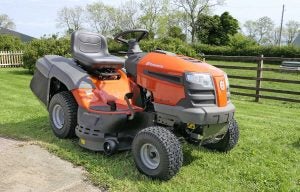
Lawn Tractors
As anyone in the market knows, lawn tractors aren’t just for mowing anymore. When shopping around, notice the different terms involved here as mowers are distinct from tractors that happen to be built for the lawn and garden. As a rule, the best lawn tractors are built to contain a mower, but also considerably more. With horsepower (HP) ranges anywhere from 18 to 25, these smaller units often measure about 45 to 50 inches at the wheelbase and often are built for attachments and may have 3-point hitches.
The John Deere E180 is a good example of this model. Built with a 25 HP V-Twin extended series engine, the machine has a forward speed up to 5.5 miles per hour with 3.2 miles per hour in reverse. Like a lot of machines in this category, the E180 features an electric power take-off (PTO). Measuring 45.7 inches in height, the lawn tractor is 76.5 inches in length, has a wheelbase of 48.9 inches, and weighs 531 pounds without fuel.
Like most John Deere equipment, the E180 is built to accessorize with attachments. In addition to a number of utility carts, riding covers, mulch kits, the lawn tractors also come with spreaders and sprayers. These machines are obviously built to accommodate mowers with decks anywhere from 42 inches upwards, but they also haul mulch carts, snow blades, and aerators. This category of tractors may have some of the greatest variability when it comes to pricing, as used models abound. But figure new well-made units at a retailer might run anywhere from $2,500 on up.
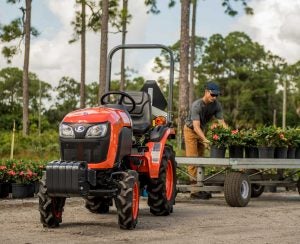
Sub-Compact Tractors
Fans of the rural lifestyle understand the value of a good sub-compact tractor, probably one of the most popular models for producers and hobbyists alike. Loosely categorized as having two- to three-cylinder diesel engines with 15 to 25 HP, these machines offer 3-point hitches and can actually double as lawn tractors for big spreads. The best sub-compact tractors bring a substantial lift capacity and are often built for bucket attachments, as well as underneath mowers, or rotary mowers pulled behind.
The Kubota BX1880, BX2380, and BX2680 series are good examples here, with gross HP ranging from 16.6 to 24.8, and PTO at 13.7 to 19.5. With a loader lift capacity of 739 pounds for a rigid bucket, and 613 pounds for the QA bucket, the unit has a three-point linkage capacity of 680 pounds, a Category I 3-point hitch, and of course is four-wheel drive. Measuring 95.5 inches in length, 44 to 45 inches in width, and up to 86 inches in height depending on the model, these units weigh between 1,300 and 1,600 pounds with a wheelbase of 55 inches.
With a Manufacturer’s Suggested Retail Price (MSRP) as low as $9,863, the Kubota machines, for example, are all built for a wide assortment of attachments, including loaders, mowers, blades, post hole diggers, and hay equipment. Sub-compact tractors can certainly handle mowing pastures or large yards, haul dirt or mulch, blast through snow, and handle small hay operations. With the right rotary tiller, they could easily work a large garden.
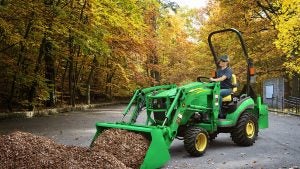
Compact Tractors
While smaller machines might suffice the rural lifestyle enthusiast, compact tractors are typically required for larger operations. Defined by the American Society of Agricultural Engineers as weighing 4,000 pounds or less, equipped with a 3-point hitch, and 40 to 60 HP, the best compact tractors can typically lift more than 2,000 pounds with a loader. Ideal for mowing, road maintenance, and snow removal, these compact tractors can also till up large gardens and haul small commercial loads.
The Compact Farmall 45C CVT is a member of the CASE IH family of machines and brings a 45 HP engine and 36 HP PTO. The tractor is actually built to accommodate an enclosed cab. The tractor measures 10.68 feet with a 69.1-inch width, height of 98.4 inches, and wheelbase if 73.2 inches. The Category I 3-point hitch has a 2,469-pound lift capacity. The tractor’s dry weight is 3,770 pounds and can handle 2,000 pounds with a front-loader.
Compatible with front-end loaders, backhoes, and rotary tillers, the compact tractors are capable of field work as well grain-hauling and any kind of snow removal or hay production. Great for small farms or businesses involved in landscaping, livestock hauling, or road work. Prices on compact models vary widely based on attachments and region, but figure $30,000 and up unless a great used machine is found.
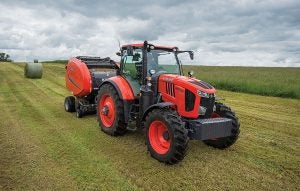
Utility Tractors
The utility tractor is loosely defined as having HPs between 40 and 100 — sometimes more. Years ago, the compact tractor filled this job, and today there is still considerable crossover between these. Several hybrids exist as compact utility tractors, which is easy to understand with the range of size being so great. Most of these models will have 4-cylinder diesel engines and may have transmissions with gearing such as 8/8, 16/16, or even 32/32. Utility tractors also feature significantly more electronics and even Artificial Intelligence (AI) systems these days.
The John Deere 6 Series Utility Tractors offer HP between 105 and 250 and can handle anything one wants to throw at them. The 625OR brings a maximum HP of 275 with 253 at the PTO ramped to 1,000 RPM. This tractor features a proprietary 8.4-inch CommandCenter display and infinitely variable transmission system with CommandPRO joystick driving strategy. Capable of 26 miles per hour out on the road, the Category 3/3N rear hitch has a maximum capacity of 22,900 pounds. Engine-wise, the diesel features a six-cylinder. The tractor’s wheelbase is 114 inches and it weighs 21,100 pounds empty. Built for heavy loads, the maximum permissible Flange axle weight is 33,000 pounds with 29,652 at the R&P.
Built for heavy work, pricing varies widely by dealer, brand, and accessories. Utility tractors can handle any kind of job from commercial snow removal to large hay operations, livestock hauling, food plot maintenance, or agricultural field work.
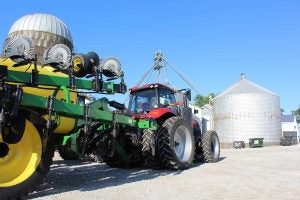
Agricultural Tractors
Technically, all tractors are agricultural tractors, but another term might be for row crop tractors. The John Deere 8 Series, as an example, offers between 230 and 410 HP with wheel, two-track, and four-track configurations. Built with the hydraulics in mind to handle large planters, these models are what city folks think of when they hear the word tractor.
The 8RX 410 Four-Track Tractor brings an engine HP of 443 max by way of its six-cylinder engine, as well as Integrated Intelligence with AutoTrac, StarFire receiver and more. The tractor’s 10-inch display is a 4600 Generation 4 CommandCenter. Rated PTO power is 310 HP, and the tractor features as transmission the e23 PowerShift with Efficiency Manager. The rear hitch is a Category 4N/3 with standard lift at 24 inches behind the hitch-point at 20,000 pounds.
The base machine weight is 43,300 pounds, with tread spacing at 76-, 80-, 88-, or 120-inch. Track width is offered in 18-, 24-, or 30-inch, with a wheelbase of 127.36 inches. Prices on agricultural tractors can go sky high, but let’s face it, folks buying these are working dealer-direct for bundled pricing.
Scope and Scale
Whether a homeowner with a few acres or a large commercial producer, there’s nothing quite like a tractor to make one feel like a farmer. Even a basic lawn tractor can readily convert to a rescue wagon when a hard snow hits and the driveway needs plowed. They’ve certainly come a long way since the old 1940s models once bounced about with bucket seats, and there’s no sign that technology is going to slow down — and a lot of this has been done in the name of “cab comfort.”
The New Holland Boomer 35- to 55-HP series offers a wide variety of options to this regard, with either the open platform or the Boomer Cab. With contoured fenders to the right and left housing the transmission, PTO, and 3-point hitch controls, the tractor’s a long way removed from the old sticks and rusty buttons. Meanwhile, the easy-to-read dashboard instrumentation includes a fuel gauge, temperature gauge, tachometer, PTO speed indicator, hour meter, cold starting aid indicator, and warning lights for engine oil pressure and battery charge.
The tractor’s steering wheel tilts for better control, and the safety-start system includes an operator-presence switch that shuts the tractor off if the seat is left. Sound dampening rubber floor mats are standard on all models, with a cup holder and tray, and foldable ROPS for easy storage.
Yes, back in the old days, an AM/FM radio tied to a side mirror with baling wire might suffice. Now, cabs are available on even sub-compact tractors and have comfort controls that rival passenger vehicles. From heating and air conditioning to radios and computers, it’s certainly not your grandpa’s tractor any more.
These days, more smaller tractors are also featuring AI, with smart planters and just the tip of the iceberg. Give it a few years, and there’s no question technology will trickle down to the good ol’ lawn tractor, and one might be able to work it remote control.
In the meantime, happy hunting, and have fun tractor shopping.
Brian Boyce is an award-winning writer living on a farm in west-central Indiana. You can see more of his work at http://www.boycegroupinc.com/. This article was written on behalf of Quality Farm Supply.



